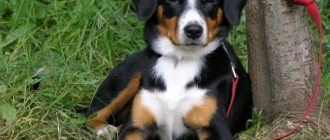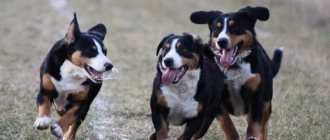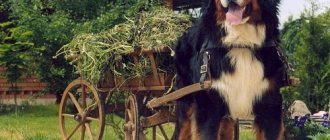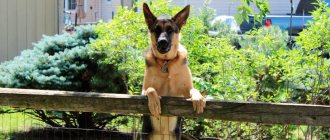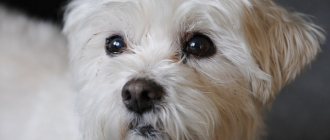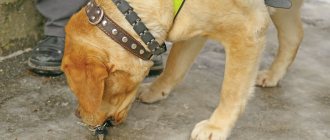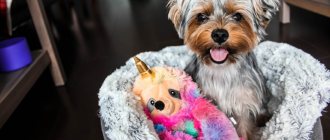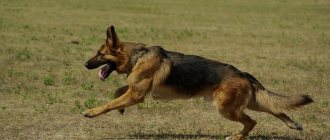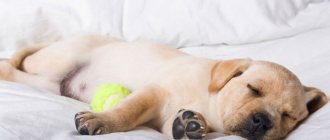Story
The Appenzeller Mountain Dog owes its appearance not to systematic breeding work, but rather to natural selection. It is assumed that his ancestors were ancient Roman war dogs who came to the Alps with Caesar's army. And, indeed, the first Sennenhunds that descended from them were distinguished by quite strong aggressiveness and fighting qualities.
However, the shepherds who inhabited the Swiss Alps from ancient times had no need for warrior dogs. They needed dogs to herd and protect herds, to help with the farm, well, in extreme cases, to protect livestock, the house and the owner, but not four-legged warriors.
During the assimilation of Roman Molossians with local dog breeds, Sennenhunds appeared. But for a long time they were a single breed, or, rather, a breed group, where animals of different weight, height and build were found.
Later, Mountain Dogs began to be bred according to their variety, thus giving rise to the four breeds of modern Swiss Cattle Dogs.
As for the Swiss Appenzeller Mountain Dog itself, it was bred in Appenzell, a historical region located in the northeast of Switzerland. Medium-sized, short-haired dogs with an elegant tricolor black-white-red or brown-white-red color were used there as assistants to local shepherds and guards. But until the beginning of the 20th century, no one viewed them as anything other than working dogs, not suitable for exhibitions and breeding. And they weren’t considered a breed then.
Recognition for the Appenzellers came later, when professional dog handlers became interested in them. In 1906, the first breed club of Appenzeller Mountain Dogs was created and a stud book was established. And in 1916, the first standard of this breed appeared.
THIS IS INTERESTING! Despite the fact that breeding work had already been carried out ten years before the development of the first standard, until 1913 Appenzeller and Entlebucher Mountain Dogs were considered one breed.
International recognition for the Appenzellers came late. Until 1989, the FCI did not recognize them as a breed. But after that, Appenzellers surprisingly quickly became one of the most popular dog breeds in the world. Nowadays, of course, they are used less and less in accordance with their original purpose and have become simply companion dogs with whom it is easy and friendly to communicate, and also favorites of numerous exhibitions and sporting competitions.
Origin story
Dogs of this type have lived in the Swiss Alps for centuries and helped farmers with difficult work. However, they were never singled out from the general mass of working “mutts”. Dr. Friedrich von Tschudi first drew attention to the Appenzellers. In his book “Animal Life in the Alpine Mountains” (1853), he describes the herding dogs of the Appenzeller region, which were medium-sized, high-voiced, with short hair of many colors, and were used mainly for guarding and herding livestock. Another name for the breed is the Appenzell Shepherd Dog.
The name of the breed comes from the Swiss “senn” - the so-called shepherds and “hund” - a dog. Appenzell is a historical region in northeastern Switzerland.
A little later, the Swiss forester, a lover of Sennenhunds, Max Weber turned to the Swiss canine community with a request for assistance in the development of the breed, to which he received a positive response and 400 francs. The first Appenzellers began to appear at exhibitions. In 1906, a stud book was opened for them and the first breed club was created under the leadership of Professor Dr. Albert Chaim, who made a significant contribution to the development of mountain herding dogs and Appenzellers in particular. In 1916, the first standard for the Appenzeller Sennenhund breed was developed. Related breeds include the Bernese Mountain Dog, Greater Swiss Mountain Dog, and Entlebucher Mountain Dog.
Video about the Appenzeller Mountain Dog breed:
Description of the breed
Description of the breed with explanatory photos:
Color
Like all other Sennenhunds, the Appenzeller is distinguished by a bright, elegant tricolor color, in which on the main background, or, as dog breeders say, the “shirt,” there are spots of other, contrasting colors: reddish-red and white. Moreover, these spots are not scattered in disarray, but are located in strict accordance with the requirements prescribed in the standard.
- Red-red: above the eyebrows, muzzle, on the inside of the ears. On the chest, on the paws (reaching approximately to the hocks), on the back of the tail.
- White: Forms a "T" shaped marking on the dog's forehead and muzzle. On the chin and on the neck, on the chest it forms a mark in the form of a cross and seems to be bordered along the edges with red spots. Also, the Appenzeller must have white paws and (preferably) the tip of the tail.
THIS IS INTERESTING! The Appenzeller is the only Mountain Dog whose standard allows not only a black base color, but also a brown color. In this case, the color of the undercoat can be black, gray or fawn (in dogs with a brown “shirt”).
This color is called “Havana”
Appearance
- The head is wedge-shaped, proportional to the body, of sufficient width, but not heavy and, moreover, not coarse.
- The wide, flat forehead is divided by a clearly visible groove. The transition to the muzzle is not abrupt, but rather smooth.
- The back of the head is not convex, but rather rounded. In this case, the skull and muzzle should be in a ratio of approximately 10:9 in length.
- The bridge of the nose is flat, the lobe protrudes slightly beyond the jaw. Cheekbones and cheeks are well developed, lips are tight-fitting and not drooping.
- The teeth are strong and straight. A scissor bite is desirable, although a pincer bite is acceptable. The absence of 1-2 permolars or molars that complete the dentition is also acceptable.
- The pigmentation of the nose, edging of the lips and eyelids is black or brown depending on the color.
- The eyes are round in shape, the inner corner of the eyelid is lowered towards the nose.
- The ears are triangular with rounded tips, relatively large in size. Their stance is wide and quite high. At rest they lie close to the sides of the head, and when excited they turn forward.
- The body is rectangular in format, but not stretched, but compact.
- The neck is quite powerful and strong, medium in length. The transition from it to the withers is not abrupt. The back is of moderate length, wide, with well-developed muscles.
- The chest is oval in shape, quite deep and moderately convex. The abdomen is moderately tucked.
- The limbs are strong, strong and muscular, their set is relatively wide. The hind legs in the stance are pulled back slightly, the elbow and hock joints are parallel to the body.
- The paws are round in shape, strong, with tightly clenched, curved toes. The pads are covered with rough and thick skin.
- The tail is quite thick and medium in length. If the dog is calm, the tail is directed downwards, but in a state of excitement it is thrown over the back, so that its tip either lies on the dog’s back, or extends over it and hangs to the side.
- The Appenzeller's coat is of medium length, very thick and even, with a well-developed undercoat of the same or lighter shade than the main color.
IMPORTANT! The Appenzeller Mountain Dog should look strong and muscular, but not rough and certainly not raw. However, excessive dryness of build is also a serious drawback.
Dimensions
- Male height: 50-58 cm.
- Bitch height: 48-56 cm.
- The weight of dogs of this breed ranges from 22 to 32 kg.
The standard does not regulate the body length of dogs of this breed, but in any case it should be proportional to height.
Puppy weight and height by month:
- 1 month : 3 – 4 kg.
- 2 months : 7 - 8 kg.
- 3 months : 9.5 - 11 kg.
- 4 months: 12.5 - 14.5 kg.
- 5 months: 16-19 kg.
- 6 months 21-23 kg.
- 7 months 22-24 kg.
- 8 months 22 - 25 kg.
- 9 months 22 - 27 kg.
- 10 months 22 - 29 kg.
IMPORTANT! After a puppy reaches the age of six months, its weight increases slightly, so the weight gain per month for an individual dog can be less than half a kilogram. Most Appenzellers, who will weigh 22-26 kilograms as adults, stop gaining weight altogether at 6 months or gain very little.
Howl and bark
Bred for herding livestock and for driving herds with a voice, the Appenzeller is not averse to barking and howling. But it depends only on the owner and how much time and effort he devotes to training his pet whether the dog will bark solely on business, say, to drive away a thief, or whether he will bark endlessly for the most insignificant reason, reacting to the slightest noise.
It is very important from an early age to teach the puppy to stay at home alone and at the same time behave silently, only in this case, after the Appenzeller grows up, he will begin to bark only when it is required of him.
History of the breed
There is no reliable information about the origin of the breed. There are four types of Mountain Dogs: the Appenzeller, the Bernese Mountain Dog, the Greater Swiss Mountain Dog, and the Entlebucher Mountain Dog.
One thing is clear, this is an old breed about which there are several theories. One of them says that Appenzellers, like other Sennenhunds, descend from an ancient Alpine dog. Archaeological research has shown that Spitz-shaped dogs have lived in the Alps for thousands of years.
Genetic studies have confirmed that the ancestors of the breed were massive dogs, light in color, intended to guard livestock. Most likely, all Swiss Cattle Dogs are descended from the same ancestor, although there is no hard evidence for this.
Until recently, communication between the two valleys in Switzerland was very difficult. As a result, dog populations, even in nearby cantons, differed significantly from each other.
There were probably dozens of different Mountain Dogs that served farmers for hundreds of years. Their service lasted longer than that of other similar breeds, since modern technology came to the Alps later than to other countries of Western Europe.
But, as a result, progress reached the most distant villages and in the 19th century the popularity of the breed decreased significantly. Many of them simply disappeared, leaving only four varieties of herding dogs.
The Appenzeller Mountain Dog was lucky because her homeland, the city of Appenzell, was located far from large cities such as Bern.
In addition, she now has a defender - Max Siber. Sieber was the main promoter of the breed and was seriously involved in its conservation. In 1895 he requested the help of the Swiss Kennel Club to preserve the Appenzellers.
The Canton of St. Gallen, the administrative district that includes the city of Appenzell, also provided assistance by collecting voluntary donations for the restoration of the breed. The Swiss Kennel Club created a special commission to breed the remaining dogs.
During the 20th century, Appenzeller Sennenhunds, although they found their way to other European countries and even to the United States, remained a rare breed. In 1993, the United Kennel Club (UKC) registered the breed and classified it as a service breed.
A small number of lovers of these dogs living in the USA and Canada organized the Appenzeller Mountain Dog Club of America (AMDCA).
The AMDCA's goal was to have the breed recognized by the largest organization, the American Kennel Club, since the three remaining Swiss Cattle Dog breeds had already been recognized.
Where is the best place to buy a puppy: nurseries
If you decide to take an Appenzeller, then it is better to buy a puppy either in a nursery or from professional breeders. This breed is still new for Russia, and therefore the list of well-known domestic nurseries dealing with this breed for 2021 is very small:
- From "Noble House"
- FIDELITY HEARD
- EBERRON
- SHEKSBURG
- Vingenium
Contacts where you can contact the breeders can be found on the websites of any of the above listed nurseries.
Price: how much does it cost
Due to the fact that there are still few dogs of this breed in Russia, and most of the producers are brought from foreign nurseries, the cost of an Appenzeller puppy cannot be small. So, a pet-class baby can be purchased for twenty thousand rubles and more, but for a promising show-class puppy you will have to pay sixty thousand and more.
Owner reviews
Believe me, you won’t find negative reviews from the owners of these wonderful dogs all over the Internet:
Alexei:
“Two years ago we became the happy owners of a miracle named Ralph of the Appenzeller Mountain Dog breed, and during all this time we have never regretted that we bought him, and not a Bernese, as we first wanted. Our dog is incredibly smart: he seems to know commands from birth and happily carries them out. He especially loves the “Voice” team, however, this is how they are supposed to be by their breed - shepherd dogs, bark when corralling cows and sheep. And we have an excellent security guard, I must say. And it's a pleasure to walk with him. We also took him on bicycle trips with us, the dog can handle all road difficulties very well. Although no, transfers is not the right word. He just enjoys it all...”
Catherine:
“Several years ago we didn’t even know these dogs existed. And then suddenly they saw him in a book on dog breeding, and that’s it - it was love at first sight. But we learned about how wonderful animals they are, these Appenzellers, only when we got our Bertha. She's just crazy smart. From a half-glance she understands what we want from her, I never remember a case where Bertha refused to carry out some command. You can safely leave her with the children: she will look after them and watch over them, so that no stranger will offend...”
Julia:
“I always dreamed of a dog, but when my husband gave me something strange, black, white and red for my birthday, and even said that it was some kind of Appenzeller that I had never heard of in my life, I was shocked. But Sam, as we named the puppy, literally charmed us not only with his unusual appearance, but also with his intelligence. It’s a pleasure to train him; he remembers all the commands right away. You wouldn't say that Sam is malicious towards strangers, but he is an excellent guard. True, sometimes a mischievous person will steal a slipper or a glove and run with it throughout the apartment, as if teasingly: “Come on, take it away!”...
Characteristics: pros and cons
pros
- + Energetic, active and cheerful.
- + Incredibly smart and quick-witted.
- + Friendly and not too aggressive.
- + These dogs have a well-developed protective instinct; they make excellent watchdogs.
- + Gets along well with other pets, including cats.
- + They are not inclined to choose only one leader in the family; they recognize all family members of their owner equally.
- + Well suited for families with children, but it is advisable that the children are not too small and understand that a dog is not a toy.
- + They are not inclined to bite and are generally not very aggressive.
Minuses
- - They can be headstrong and stubborn.
- — If you don’t pay attention to upbringing, they can become empty-headed.
- — They need great physical activity, which is not always possible to provide in urban conditions.
- — These dogs definitely need to be “puzzled” with some kind of task, otherwise the Appenzeller may acquire bad habits, and his character in this case acquires destructive traits.
- - They tolerate loneliness relatively poorly and need constant contact with the owner, for this reason Appenzellers cannot be kept on a chain.
Conditions of detention
Where is it better to live: in an apartment or a house?
The Appenzeller was bred in the mountains of Switzerland as a working farm dog. Undoubtedly, this dog will feel best in a country house, but at the same time, he can easily live in a city apartment. True, provided that he is provided with sufficient physical activity.
How should you walk?
- In rural areas, the Appenzeller must be given the opportunity not only to walk on a leash, but also to run in the forest or meadow, away from roads and cars.
- In the city, a dog of this breed must be walked at least twice a day, and the walks should be long.
- The Appenzeller can only be allowed to run without a leash in fenced special areas.
- Active games outside are useful, as well as swimming in the warm season.
- And, finally, it would be nice to take your pet out of town at least once a week, into nature, where he could run around to his heart’s content, away from people, cars and stray dogs.
Appenzeller Mountain Dog - care
As confirmed by reviews from owners, maintaining the breed does not pose any difficulties. An adult representative and a puppy Appenzeller Mountain Dog need a number of manipulations:
- walks;
- bathing;
- combing;
- cleaning ears and teeth;
- nail trimming;
- proper nutrition.
Adult dogs and Appenzeller Mountain Dog puppies require active walks twice a day. The dog is rarely bathed no more than twice a year during the molting period. After walks, paws are cleaned. If the contamination is significant, then you can use dry shampoo, for example, Trixie. The wool is brushed once a month. During the molting period, the number of procedures is increased to help the animal get rid of a large number of dead hairs. Every week, the eyes, ears and teeth are cleaned, and the claws are removed if they are not worn down naturally during walks.
What to feed your Appenzeller Mountain Dog?
The owner himself chooses what is best for him to feed his pet. The Mountain Dog breed can be given dry food or natural products. Regardless of what is chosen, it is important that the pet always has access to clean water. Puppies are fed about 5 times a day. Single serving – 75 g. Adults are called into the bowl no more than 2 times. Portions are increased to 250 g. When choosing dry food, it is recommended to give preference to the premium line, for example, Dog Six Fish Fresh or Free-Run Duck.
Having given preference to natural products, the diet of the Appenzeller Mountain Dog must necessarily contain:
- lean meat;
- porridge;
- vegetables and fruits;
- sea fish;
- cottage cheese;
- eggs.
The following products are prohibited:
- fatty and smoked meat;
- sweets;
- semi-finished meat products;
- hollow bones.
Necessary care
Feeding
The Appenzeller Mountain Dog is not one of the problem breeds that require special diets. You can feed him either dry factory food of no lower than premium class (show dogs are better given food of super premium class and higher), or natural products.
If the choice is made in favor of natural food , then you need to take into account that meat and meat products should account for no less than half of the daily diet, and the rest, in addition to cereals, should also include fermented milk, vegetables and fruits. Also, when feeding naturally, it is necessary to give the dog vitamin and mineral complexes.
ATTENTION! If a dog suffers from urolithiasis, then it is best to feed it with special dietary food, rather than create a feeding diet yourself.
It should be remembered that Appenzellers are big eaters, and if you do not give them enough exercise, they gain excess weight very quickly . Therefore, you need to give your dog only its food allowance, and not supplement it with tasty treats from your table.
Important articles on nutrition:
- Compatibility test: can a dog have milk and fermented milk products?
- Feeding for all occasions: what to feed your dog in 20 specific cases
- Tips and recipes from experienced dog handlers: porridge for dogs
Washing and grooming
The Appenzeller is a short-haired dog and caring for him is not particularly difficult:
- combed at least 1-2 times a week; during the molting period, this procedure should be carried out daily.
- Eyes and ears are cleaned as needed, and nails are trimmed as they grow.
- It is also necessary to monitor the condition of your pet's teeth and brush them as needed.
- But it is not recommended to bathe the Appenzeller often. Ideally, wash it twice a year, and it would be better during shedding, using a dog wash. If your dog gets dirty and it’s too early to bathe him, you can either wash off the dirt with plain water or use dry shampoo .
Care and maintenance
Despite the fact that Appenzellers' coat changes year-round and sheds twice a year, caring for them is not difficult. You can purchase a special glove or brush and periodically run it over the dog’s body. In this way, lost hair and dead skin particles will be removed, and it is also a kind of massage that will not harm the dog.
You also need to periodically use various flea products. It is necessary to follow generally accepted rules of hygiene: clean your pet’s teeth, eyes and ears as needed. You need to keep an eye on the claws and trim them if necessary.
It is better to do this on special sites equipped with various obstacles. Also, from an early age, teach a dog living in an apartment to be clean and relieve itself outdoors.
Training and education
- It is necessary from the very beginning to make the appenzeller understand who is in charge in the house, and that any member of the owner’s family is higher in rank than the dog.
- When training a dog of this breed, you need to remember that until the animal runs around to its heart’s content, it will not be able to fully engage: it will be constantly distracted, which may make it worse for them to remember commands.
- It is very important to do this without harsh coercion, no matter how ridiculous it may sound, but it is better to come to an agreement with the dog peacefully than by tugging on the leash and screaming, not to mention beating.
IMPORTANT! The owner of an Appenzeller should always be able to insist on his own, this will help the dog better understand that he must obey his owner unquestioningly. You also need to decide from the very beginning what the animal can do and what it cannot do, and in the future you need to be consistent and not allow the dog to do things that five minutes ago were strictly prohibited.
Appenzeller Mountain Dog - training
To live a full life, a dog needs to develop obedience. The puppy must understand who is the leader in the pack from the first days of being in the house. The Appenzeller Mountain Dog needs training from an early age, around 2-3 months. This is the only way to achieve the greatest success. Thanks to their intelligence and quick wit, dogs quickly learn commands; the main thing is to get them interested in activities in a playful way.
At first you will need to be patient, because the Appenzeller Mountain Dog is hyperactive, but natural obedience and curiosity will do their job. Upon reaching the age of 8 months. you can add elements (commands) that form restrictions. Each positive result should be rewarded with a tasty treat or petting, it all depends on the pet’s preferences.
Differences from Entlebucher
The main difference between these breeds is size. The Entlebucher Mountain Dog is noticeably smaller than the Appenzeller , and therefore may be better suited for a city apartment than its larger “relative.” For a private house and, especially, a farm, a larger appenzeller is much better suited.
Appenzeller/Bernski/Gross/Entlebucher
Swiss Mountain Dog or Labrador: which one to choose?
This question is quite difficult to answer, if only because these breeds were bred for different purposes, which affected their character and appearance.
The Appenzeller was originally a herding dog, but which, nevertheless, was also supposed to guard the house.
Labrador is a hunting breed, designed to track and then present killed game to the hunter. Nowadays, Labradors have also become companion dogs, but they have not lost their hunting instincts, but have not acquired protective qualities.
Therefore, answering the question of who to choose - an Appenzeller or a Labrador, you can answer this way: if you need a guard dog, then it is better to choose an Appenzeller Mountain Dog, but if you are a hunter, then a Labrador would be preferable for you. In general, the choice of one breed or another is a matter of personal taste of the potential owner.
Appenzeller Mountain Dog - nicknames
The dog must be named once and for all. It should be simple and easy to pronounce, because it will sound a huge number of times throughout the day. The Appenzeller Mountain Dog breed is so versatile that there are a huge number of options for puppies. You can name your pet after your favorite hero, city, or so that the nickname matches your character and behavior. Among the popular nicknames for boys you can choose:
- Archie;
- Rolf;
- Pele;
- Luke;
- Phil.
Nicknames that are popular among girls are:
- Jesse;
- Lucy;
- Kara;
- Taya;
- Molly.
Interesting Facts
- The Appenzeller Mountain Dog was bred in Appenzell, a historical region located in northeastern Switzerland, also famous for a special type of cheese that is produced only there.
- These dogs feel the emotions and mood of their owners so sensitively that sometimes it may seem as if they read people's thoughts.
- Currently, Appenzeller Mountain Dogs are used as rescue dogs: they help find people after avalanches or other natural disasters, in this they are greatly helped by the inherent intelligence, independence and loud barking of dogs of this breed, which in other circumstances is considered a disadvantage by many.
Photo
Video
The nuances of raising a dog of this breed:
The Appenzeller Mountain Dog is medium in size among the Swiss herding breeds and, like its larger “relatives,” is distinguished by its courage, intelligence and quick wit. It has naturally good protective qualities. This dog is sweet and kind around the family, but distrustful of strangers, although not aggressive towards them.
He can live both in a house and in a city apartment, since he does not need much space. The Appenzeller Mountain Dog, if properly raised and trained, will certainly become a devoted friend and a wonderful guard dog. And you will never regret choosing it.
Share stories about your Appenzellers, experiences and tips on keeping or breeding them, as well as photos of your pets of this wonderful breed in the comments to this article.
Description of the Appenzeller Mountain Dog
Representatives of this breed are popular all over the world. They can be kept in private houses or apartments. They are reminiscent of Rottweilers in character. It is important for these animals that the owner is always nearby. For correct and adequate behavior, you need to socialize and raise your pet in time. The description of the Appenzeller Mountain Dog breed indicates a high level of intelligence and performance of the animal.
Training should take place in the form of active play and not depress the dog. These dogs are used in rescue operations related to searching for people in the mountains or after natural disasters. Many people are interested in how much an Appenzeller Mountain Dog costs. Dogs can be purchased from kennels, where the average price is $700.
History of the Appenzeller Mountain Dog breed
The breed owes its appearance not to systematic selection, but to natural selection. There is a version that the Romans brought their powerful guard dogs into the country, which bred with herding dogs. As a result, a new breed appeared that was used to help herd herd animals. Initially, this was problematic because the dogs were very angry and attacked animals more than they protected them.
A long period of assimilation was required. The dog got its name from the canton of Appenzell, which is located in the east of the country. At first it was one type of animal, which only after a while was divided into several separate breeds based on external characteristics. The first club was founded in 1906, while the official recognition of the Sennenhund dog occurred in 1989, despite the fact that the historical roots of the origin of the breed go far into the past.
Appenzeller Mountain Dog – standard
The Swiss Appenzeller Mountain Dog breed is endowed with external standards:
- grow at the withers up to 50-56 cm;
- average weight is 22-32 kg;
- the head is wedge-shaped with smooth transitions to the muzzle;
- triangle ears are wide and have rounded tips;
- eyes are almond-shaped, dark in color;
- the nose is straight with a large brown tint;
- scissor bite;
- the body is rectangular and compact;
- the chest is oval in shape, the stomach is retracted;
- limbs are strong and wide apart;
- rounded paws with curved toes;
- thick, medium-length tail;
- The medium-length coat is thick and even with a thick undercoat;
- color black or brown with bright red-red and white splashes.
